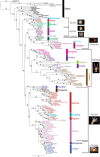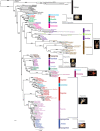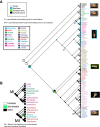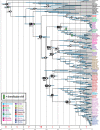A comprehensive and integrative reconstruction of evolutionary history for Anomura (Crustacea: Decapoda)
- PMID: 23786343
- PMCID: PMC3708748
- DOI: 10.1186/1471-2148-13-128
A comprehensive and integrative reconstruction of evolutionary history for Anomura (Crustacea: Decapoda)
Abstract
Background: The infraorder Anomura has long captivated the attention of evolutionary biologists due to its impressive morphological diversity and ecological adaptations. To date, 2500 extant species have been described but phylogenetic relationships at high taxonomic levels remain unresolved. Here, we reconstruct the evolutionary history-phylogeny, divergence times, character evolution and diversification-of this speciose clade. For this purpose, we sequenced two mitochondrial (16S and 12S) and three nuclear (H3, 18S and 28S) markers for 19 of the 20 extant families, using traditional Sanger and next-generation 454 sequencing methods. Molecular data were combined with 156 morphological characters in order to estimate the largest anomuran phylogeny to date. The anomuran fossil record allowed us to incorporate 31 fossils for divergence time analyses.
Results: Our best phylogenetic hypothesis (morphological + molecular data) supports most anomuran superfamilies and families as monophyletic. However, three families and eleven genera are recovered as para- and polyphyletic. Divergence time analysis dates the origin of Anomura to the Late Permian ~259 (224-296) MYA with many of the present day families radiating during the Jurassic and Early Cretaceous. Ancestral state reconstruction suggests that carcinization occurred independently 3 times within the group. The invasion of freshwater and terrestrial environments both occurred between the Late Cretaceous and Tertiary. Diversification analyses found the speciation rate to be low across Anomura, and we identify 2 major changes in the tempo of diversification; the most significant at the base of a clade that includes the squat-lobster family Chirostylidae.
Conclusions: Our findings are compared against current classifications and previous hypotheses of anomuran relationships. Many families and genera appear to be poly- or paraphyletic suggesting a need for further taxonomic revisions at these levels. A divergence time analysis provides key insights into the origins of major lineages and events and the timing of morphological (body form) and ecological (habitat) transitions. Living anomuran biodiversity is the product of 2 major changes in the tempo of diversification; our initial insights suggest that the acquisition of a crab-like form did not act as a key innovation.
Figures




Similar articles
-
ORDER within the chaos: Insights into phylogenetic relationships within the Anomura (Crustacea: Decapoda) from mitochondrial sequences and gene order rearrangements.Mol Phylogenet Evol. 2018 Oct;127:320-331. doi: 10.1016/j.ympev.2018.05.015. Epub 2018 May 23. Mol Phylogenet Evol. 2018. PMID: 29800651
-
Depth as a driver of evolution and diversification of ancient squat lobsters (Decapoda, Galatheoidea, Phylladiorhynchus).Mol Phylogenet Evol. 2022 Jun;171:107467. doi: 10.1016/j.ympev.2022.107467. Epub 2022 Mar 26. Mol Phylogenet Evol. 2022. PMID: 35351636
-
Galatheoidea are not monophyletic - molecular and morphological phylogeny of the squat lobsters (Decapoda: Anomura) with recognition of a new superfamily.Mol Phylogenet Evol. 2011 Feb;58(2):157-68. doi: 10.1016/j.ympev.2010.11.011. Epub 2010 Nov 21. Mol Phylogenet Evol. 2011. PMID: 21095236
-
'Fish' (Actinopterygii and Elasmobranchii) diversification patterns through deep time.Biol Rev Camb Philos Soc. 2016 Nov;91(4):950-981. doi: 10.1111/brv.12203. Epub 2015 Jun 23. Biol Rev Camb Philos Soc. 2016. PMID: 26105527 Review.
-
Contextualising primate origins--an ecomorphological framework.J Anat. 2016 Apr;228(4):608-29. doi: 10.1111/joa.12441. Epub 2016 Feb 2. J Anat. 2016. PMID: 26830706 Free PMC article. Review.
Cited by
-
Evolvability in the Cephalothoracic Structural Complexity of Aegla araucaniensis (Crustacea: Decapoda) Determined by a Developmental System with Low Covariational Constraint.Biology (Basel). 2022 Jun 24;11(7):958. doi: 10.3390/biology11070958. Biology (Basel). 2022. PMID: 36101339 Free PMC article.
-
Functional morphology of giant mole crab larvae: a possible case of defensive enrollment.Zoological Lett. 2016 Aug 26;2(1):17. doi: 10.1186/s40851-016-0052-5. eCollection 2016. Zoological Lett. 2016. PMID: 27570630 Free PMC article.
-
Scent of death: Evolution from sea to land of an extreme collective attraction to conspecific death.Ecol Evol. 2019 Feb 10;9(4):2171-2179. doi: 10.1002/ece3.4912. eCollection 2019 Feb. Ecol Evol. 2019. PMID: 30847102 Free PMC article.
-
The complete mitochondrial genome of a yeti crab Kiwa tyleri Thatje, 2015 (Crustacea: Decapod: Anomura: Kiwaidae) from deep-sea hydrothermal vent.Mitochondrial DNA B Resour. 2017 Mar 10;2(1):141-142. doi: 10.1080/23802359.2017.1289347. Mitochondrial DNA B Resour. 2017. PMID: 33473745 Free PMC article.
-
Convergent Evolution of Armor: Thermal Resistance in Deep-Sea Hydrothermal Vent Crustaceans.Biology (Basel). 2024 Nov 21;13(12):956. doi: 10.3390/biology13120956. Biology (Basel). 2024. PMID: 39765623 Free PMC article.
References
-
- Chablais J, Feldmann RM, Schweitzer CE. A new Triassic decapod, Platykotta akaina, from the Arabian shelf of the northern United Arab Emirates: earliest occurrence of the Anomura. Palaeontologische Zeitschrift. 2011;85(1):93–102. doi: 10.1007/s12542-010-0080-y. - DOI
-
- Macpherson E, Segonzac M. Species of the genus Munidopsis (Crustacea, Decapoda, Galatheidae) from the deep Atlantic Ocean, including cold-seep and hydrothermal vent areas. Zootaxa. 2005;1095:3–60.
-
- Dawson EW. King crabs of the world (Crustacea: Lithodidae) and their fisheries: a comprehensive bibliography. Misc Publ. 1989;101:338.
-
- Lovrich GA. La pesqueria mixta de las centollas Lithodes santolla y Paralomis gradulosa (Anomura: Lithodidae) en Tierra del Fuego, Argentina. Investig Mar. 1997;25:41–57.
-
- Wehrtmann IS, Acuna E. In: The Biology of Squat Lobsters. Poore GCB, Ahyong S, Taylor J, editor. Museum Victoria: CSIRO Publishing; 2011. Squat Lobsters Fisheries; pp. 297–322.
Publication types
MeSH terms
LinkOut - more resources
Full Text Sources
Other Literature Sources
Molecular Biology Databases

